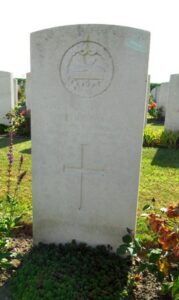The memorial in the Aberystwyth Post Office is to the men of the Aberystwyth Postal District who fell in the Great War. Some of these men were locals, who are commemorated on the main Borough War Memorial. The memorial is in the form of a bronze plaque, which looks to have been over-enthusiastically polished.
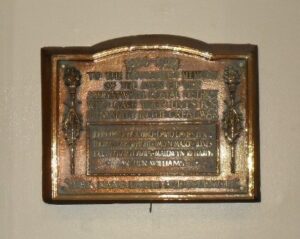
The Great War, 1914-1918
John Frederick Bird, Private, 76348, Royal Army Medical Corps. John was born in 1892, the son of Frederick and Kate Bird, of 7, South Road, Aberystwyth. He enlisted at Aldershot on 25 October 1915 and went to France in June 1916 with the 5th Field Ambulance, Royal Army Medical Corps. The 5th FA was attached to the 2nd Division, and John would have treated many wounded men during the Battle of the Somme that year. In March 1917 the Division followed the German Retreat to the Hindenburg Line, and in April they fought at Arras, during the First Battle of the Scarpe, the Battle of Arleux and the Third Battle of the Scarpe. Their next major action was at the Battle of Cambrai. The Division was still in the area when John was killed in action on 18 February 1918. He was 25 years old, and is buried in the British Extension of Metz-en-Couture Communal Cemetery, France.
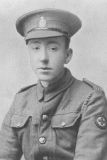
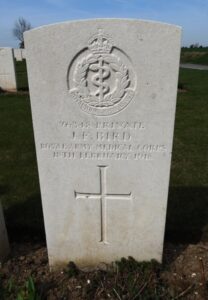
Thomas Cartwright, Bombardier, 730060, Royal Field Artillery. Tom was born in Market Drayton, Shropshire on 13 January 1884, the son of Henry and Evelyn Cartwright. He was a local postman and well known in Aberystwyth as a former player and secretary of Aberystwyth Town FC. Thomas married Edith Mary Banford at Aberystwyth in 1903. He was a pre-war territorial with the Cardigan Battery, and reported for duty at the Drill Hall in Aberystwyth on 4 August 1914. Following training and home duties the battery left for Egypt in December 1915 but soon after Tom returned home having completed his period of service. Later in 1916 Tom rejoined the army and was posted to the 85th Battery 11th Brigade, Royal Field Artillery. During the Third Battle of Ypres he was severely wounded in the back and was taken to 61 Casualty Clearing Station where he died of his wounds on 7 October 1917, aged 32. Tom is buried in Dozinghem Military Cemetery, Belgium.
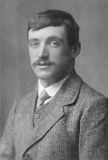
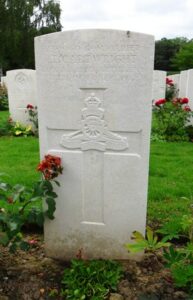
John Richard Davies, Private, 8546, Royal Welsh Fusiliers. Richard, known locally as Dick, was the son of Richard and Sarah Davies, of 1, Penglais Road, Aberystwyth. Dick played football for Aberystwyth Town FC and was a local postman who had who had served in India for seven years as a regular soldier. At the outbreak of war, he rejoined his regiment, the 2nd Battalion, Royal Welsh Fusiliers, and embarked for France, where it was attached to 19 Infantry Brigade, under independent command. The Brigade took part in the retreat from Mons to the Marne, where John rescued a wounded comrade under heavy fire at La Ferté-sous-Jouarre. The BEF then headed for Ypres, where 19 Brigade became attached to the 6th Division, and fought at the First Battle of Ypres. On 31 May 1915 the Brigade transferred to the 27th Division, and three months later transferred to the 2nd Division, taking part in the Battle of Loos. The 2nd RWF suffered terrible casualties at Loos, and remained in the Cambrin sector over the winter. On 15 March 1916, John was with ‘A’ Company, which was in the front line at the Brickstacks, when he was killed by a German rifle grenade. He was 29 years old, and is buried in Cambrin Military Cemetery, France.
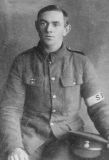
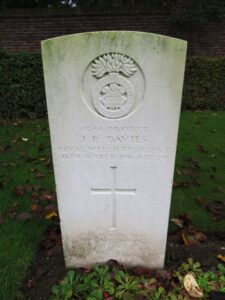
Emlyn Mason Jones, Gunner, 102654, Royal Garrison Artillery. Emlyn was the son of Edward and Laura Louisa Jones, of Gwynfa, Ponterwyd. Emlyn enlisted at Aberystwyth on 8 December 1915 into the Royal Artillery, and on 12 August 1916 was posted to the 236th Siege Battery, Royal Garrison Artillery, landing in France on 30 January 1917. The battery moved to positions near Ypres, where it supported the Allied assault on the Passchendaele Ridge from 31 July 1917 onwards. Emlyn was killed in action at Ypres on 22 December 1917. He was 21 years old, and is buried at Klein-Vierstraat British Cemetery, Belgium. His brother Iorwerth also fell. He was described as a man of unblemished character and his senior officer, Major Colman, wrote to his parents to say; “The loss to me is great, for he was one of those remaining who had shared all the discomforts of the twelve months we have spent overseas together.”
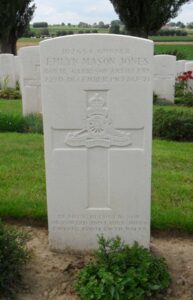
David Davies Lewis, Private, 24929, Royal Welsh Fusiliers. David was born in 1889, the son of Jenkin and Mary Anne Lewis, of Rhiwmynach, Devils Bridge. He was a Postman prior to the war, and enlisted at Aberystwyth into the 13th Battalion, Royal Welsh Fusiliers. The battalion was attached to 113 Brigade, 38th (Welsh) Division, and landed in France on 2 December 1915, spending their first winter in the trenches near Armentieres. David was killed in action during a particularly hard spell in the trenches at Cuinchy on 18 February 1916. He was 26 years old, and is buried at Guards Cemetery, Windy Corner, Cuinchy, France. His brother, John, was killed on the Somme on 1 July 1916.
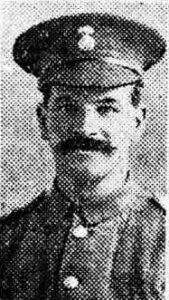
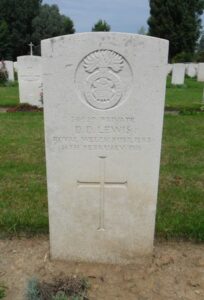
Maldwyn Richards, Corporal, 320175, Welsh Regiment. Maldwyn was born in Machynlleth in 1881, the son of Evan and Ellen Richards. He was a Postman at Aberystwyth prior to the war, and had served with the Pembroke Yeomanry. At the outbreak of war Maldwyn was called up, joining the Pembroke Yeomanry at Lampeter. During March 1916 the 1/1st Pembroke Yeomanry moved to Egypt, where it merged with the Welsh Border Mounted Brigade and formed the 4th Dismounted Brigade. On 2 February 1917 it merged with the 1/1st Glamorgan Yeomanry to form the 24th Battalion, Welsh Regiment, and became attached to 231 Brigade, 74th (Yeomanry) Division. The Division had formed in Egypt in January 1917 and had fought through the Palestinian Campaign, at the Battles of Gaza and the Battle and capture of Jerusalem. Maldwyn was killed during the march to Jerusalem on 31 October 1917, aged 36. He is commemorated on the Jerusalem Memorial, Israel.
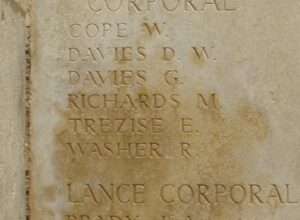
Arthur Williams, Lance Corporal, 26541, South Wales Borderers. Arthur was the son of Edward and Emma Williams of 9 Penhelig, Aberdovey and resided in Aberystwyth, where he worked as a Postman. He enlisted at Aberystwyth into the South Wales Borderers, and was posted to France during 1916, joining the 1st Battalion, South Wales Borderers, which was attached to 3 Brigade, 1st Division. Arthur would have fought on the Somme with the division during the summer of 1916. The division followed the German retreat to the Hindenburg Line in early 1917, and was then briefed for an operation on the Flanders Coast, moving there during the summer of 1917. Whilst on the coast, the Third Battle of Ypres had stalled in the mire, and the Division was recalled to Ypres, where they fought at the Second Battle of Passchendaele. On 10 November 1917 the battalion took up a position north of Passchendaele village which had been taken a few days earlier by the Canadian forces, tasked with the capture of the Goudberg Spur. Zero hour was at 5.00 am, but by mid morning the appalling conditions, combined with an irregular artillery barrage and German counter attacks caused the attack to falter with little gained. The battalion suffered 372 casualties and among them was Arthur who was killed in action that day, aged 22. The attack on 10 November brought an end to the Third Battle of Ypres or as it is better known, “Passchendaele”. Arthur is buried in Poelcapelle British Cemetery, Belgium.
